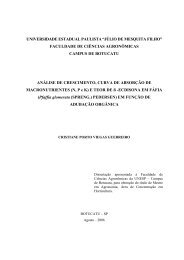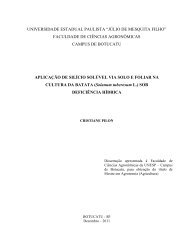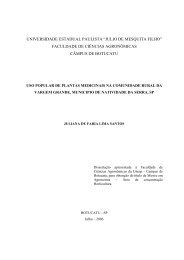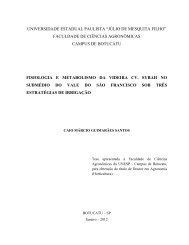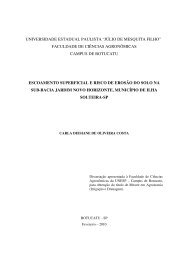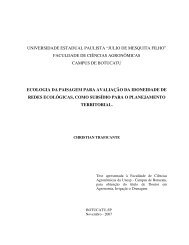abrir - Faculdade de Ciências Agronômicas - Unesp
abrir - Faculdade de Ciências Agronômicas - Unesp
abrir - Faculdade de Ciências Agronômicas - Unesp
Create successful ePaper yourself
Turn your PDF publications into a flip-book with our unique Google optimized e-Paper software.
3<br />
BIOECOLOGY OF BRONZE BUG Thaumastocoris peregrinus Carpintero & Dellapé<br />
(HEMIPTERA: THAUMASTOCORIDAE) IN EUCALYPTUS AND PROSPECTION OF<br />
NATURAL ENEMIES. Botucatu, 2010. 80 p. Dissertation (Master Science in<br />
Agronomy/Plant Protection) - <strong>Faculda<strong>de</strong></strong> <strong>de</strong> Ciências Agronômicas, Universida<strong>de</strong> Estadual<br />
Paulista.<br />
Author: EVERTON PIRES SOLIMAN<br />
Adviser: CARLOS FREDERICO WILCKEN<br />
SUMMARY<br />
The bronze-bug Thaumastocoris peregrinus (Hemiptera: Thaumastocoridae) is originated<br />
from Australia and was sprea<strong>de</strong>d rapidly in eucalyptus plantations in different countries In<br />
Africa and South America. In Brazil, he was <strong>de</strong>tectedin 2008 in staes of Sao Paulo and Rio<br />
Gran<strong>de</strong> do Sul. There is few information about its biology, then, this study aimed to<br />
<strong>de</strong>termine the bioecology of T. peregrinus in different Eucalyptus species and hybrids and at<br />
different temperatures, besi<strong>de</strong>s to evaluated some natural enemies. In bioecology study were<br />
used the species Eucalyptus camaldulensis, E. urophylla, E. grandis and three clonal hybrids<br />
among these species in climated chamber at 26 ± 1° C, 70% ± 10% and photophase of 12 h.<br />
The species E. urophylla was the species choosed for bioecology study at temperatures of 14,<br />
18, 22, 26 and 30 ± 1° C, maintained the same RH and photophase conditions of previous<br />
study. The survey of potential natural enemies was carried outthrough field observations and<br />
laboratory tests. The biology of different materials indicated E. urophylla and E. grandis were<br />
the best to <strong>de</strong>velopment and reproduction of T. peregrines. However, the insect <strong>de</strong>veloped and<br />
produced fertile offspring in all treatments. The temperature directly influenced the duration of<br />
the cycle stages, and at lower temperatures <strong>de</strong>velopment was <strong>de</strong>layed comparing to higher<br />
temperatures. Nevertheless the bronze bug could be <strong>de</strong>veloped and produce fertile offspring in<br />
all temperatures tested. In the field survey it was foun<strong>de</strong>d few natural enemies being some<br />
predatory insects have adapted to prey the pest. In the field was diagnosed predation of<br />
nymphs of T. peregrinus by Chrysoperla externa (Neuroptera: Chrysopidae) and infection by<br />
Entomophtorales spp. in adults and nymphs. In laboratory conditions, the predator Atopozelus<br />
opsimus (Hemiptera: Reduviidae) fed both nymphs and adults. T. peregrinus <strong>de</strong>veloped and



